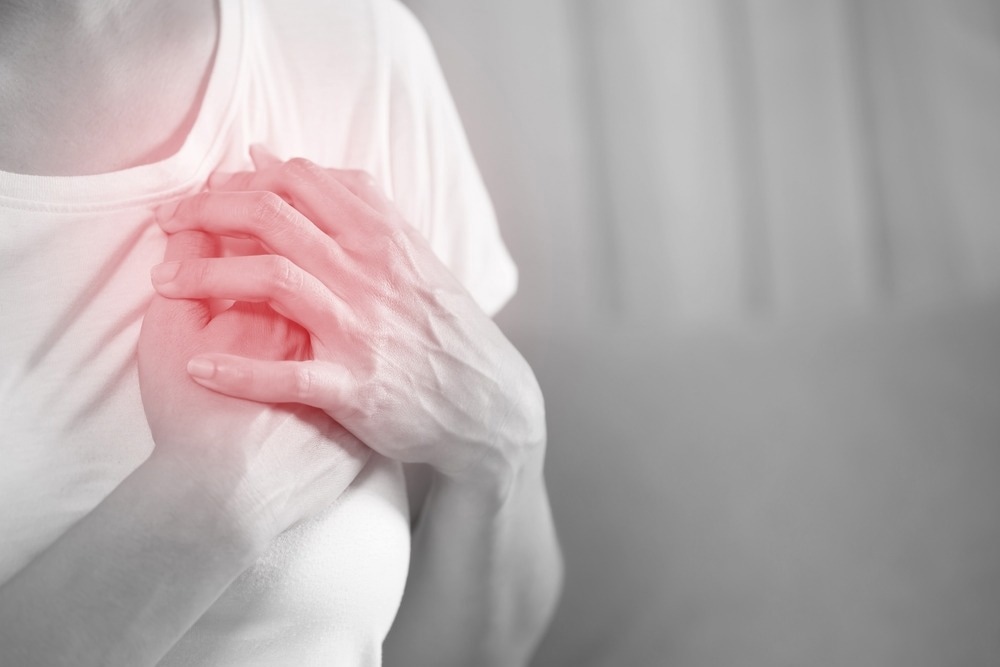Scientists have recently reviewed and summarized the evidence regarding diagnosing and treating acute myocarditis. This review has been published in the JAMA Network journal.

Study: Diagnosis and Treatment of Acute Myocarditis. Image Credit: fongbeerredhot/Shutterstock.com
Background
Myocarditis is an inflammatory myocardium injury associated with the cardiac conduction system and pericardial layers. Common events that occur during acute myocarditis are chest pain, palpitations, syncope, and dyspnea.
Endomyocardial biopsy (EMB) and autopsy analysis of individuals who suffered acute myocarditis revealed inflammatory infiltrates in the setting of non-ischemic cardiomyocyte necrosis. Cardiac magnetic resonance (CMR) has been used as a non-invasive diagnosis of acute myocarditis.
The study
All relevant PubMed articles published between January 1, 1982, and December 7, 2022, were obtained. Although 7,283 articles were retrieved, 98 fulfilled all study criteria and were included in the present review.
These included clinical trials, meta-analyses, observational studies, case reports, autopsy studies, scientific statements, systemic reviews, and consensus documents.
Diagnosis of myocarditis
Several causes of myocarditis have been identified that include viruses (e.g., parvovirus B19, coronaviruses, and influenza), parasites, autoimmune disorders, drugs including immune checkpoint inhibitors, and vaccines (e.g., mRNA COVID-19 and smallpox vaccines).
In addition, a family history of myocarditis or cardiomyopathy and toxic substances, such as amphetamine, and scorpion bites, are associated with the manifestation of acute myocarditis.
Patients with acute myocarditis have increased inflammatory markers (e.g., C-reactive protein) and troponin levels. Troponin I or T levels were elevated in around 64% to 100% of patients.
Similarly, an increased C-reactive protein level was found in approximately 54% to 99% of patients. During the initial phase of myocarditis, left ventricular (LV) dimensions remain normal, and LV ejection fraction (LVEF) is preserved in ~75% of patients.
In addition, these patients have electrocardiographic changes of ST-T segments and abnormalities in echocardiographic wall motion, particularly in the inferior and lateral walls. An abnormal electrocardiogram (ECG) finding is obtained in 62% to 96% of patients with acute myocarditis.
Serological analysis can detect Lyme myocarditis and myocarditis linked to the human immunodeficiency virus (HIV). As stated above, acute myocarditis can be diagnosed via cardiac amgentic resistance (CMR) with or without the endomyocardial biopsy (EMB) approach.
CMR helps detect cardiac edema in patients. Coronary computed tomography (CT) and coronary angiography are performed in approximately 46% to 95% of adult patients with acute myocarditis. These tests are performed in adults who complain of chest pain with ST-T changes or anomalies in the echocardiogram.
Coronary angiography/CT also helps rule out coronary anatomic abnormalities during pregnancy or postpartum.
Coronary CT helps diagnose the acute coronary syndrome, arrhythmias, tachycardia, and unstable hemodynamics. Fludeoxyglucose–positron emission tomography imaging is used to detect cardiac sarcoidosis with myocarditis. It is also used to detect myocarditis due to systemic autoimmune disease.
Different treatments for myocarditis
Treatment for acute myocarditis is designed based on the severity, etiology, and clinical presentation. Patients are categorized as per the complicated forms of myocarditis.
Typically, complicated myocarditis shows acute heart failure, LV systolic dysfunction, ventricular arrhythmias, cardiogenic shock, or advanced atrioventricular conduction disturbance.
However, uncomplicated myocarditis is associated with chest pains which can be easily treated with nonsteroidal anti-inflammatory drugs (NSAIDs), such as aspirin, to alleviate the chest pain.
Patients treated with NSAIDs did not present any significant difference in the reduction of inflammatory injury and LVEF compared to those not subjected to similar treatment.
β-blockers provided better results in patients with myocarditis. Patients with reduced LVEF and stable hemodynamics were treated with angiotensin-converting enzyme inhibitors, mineralocorticoid receptor antagonists, β-blockers, sodium-glucose cotransporter two inhibitors, and angiotensin receptor–neprilysin inhibitors.
The etiology of myocarditis must be identified, and the underlying cause must be treated.
For instance, acute myocarditis manifests as conduction disturbances due to second and third-degree atrioventricular block and ventricular arrhythmias and may require a pacemaker, antiarrhythmic drugs, or defibrillation.
Patients who develop severe LV systolic dysfunction generally require inotropic agents like epinephrine, norepinephrine, and milrinone. These patients are also treated with temporary mechanical circulatory supports, such as venoarterial extracorporeal membrane oxygenator, intra-aortic balloon pump, or intra-aorticaxial pumps.
Suppose the patients cannot be removed from temporary mechanical circulatory supports after two to three weeks. In that case, they are subjected to a long-term LV assist device, or an urgent heart transplant is considered.
After a heart transplant, about 5% of patients develop recurrent myocarditis. Treatment for this group of patients is controversial; only one randomized clinical trial assessed the efficacy of immunosuppression for acute myocarditis.
Notably, high-intensity physical exercise intensifies myocarditis. Clinicians recommend restriction in competitive sports or any form of intense physical activity for three to six weeks after the diagnosis.
After six months of diagnosis of acute myocarditis, clinicians typically measure troponin levels and order ECG ambulatory monitoring, echocardiogram, and a CMR, to investigate cardiac function.
Typically, a treadmill exercise test is ordered to evaluate the patient’s condition before asking them to resume their normal physical activities.
Conclusion
Acute myocarditis affects 4-14 people per 100,000 per year annually. The first line of therapy depends on the severity, clinical presentation, and etiology. The study concludes that randomized clinical trials are necessary to determine optimal therapeutic interventions to tackle acute myocarditis.